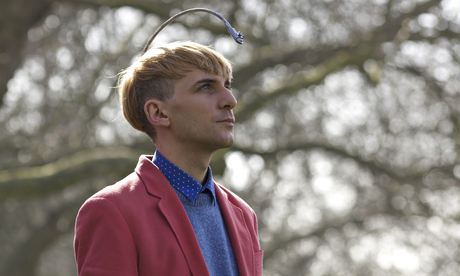
"I can have phone calls to my head," says Neil Harbisson, sitting across the table from me. Dangling over his forehead is an antenna that curves up and over from the back of his skull. The device, which he calls an "eyeborg", was recently upgraded, meaning his skull is now Bluetooth-enabled. "I can either connect to devices that are near me," he says, "or I can connect to the internet. So I can actually connect to anywhere in the world."
Next to Harbisson in this London cafe is his long-term artistic collaborator, Catalan choreographer Moon Ribas, who has a sensor implanted in her left arm that vibrates whenever an earthquake occurs. "I feel very connected to the Earth," says Ribas, who incorporates these vibrations into her performances.
Her implant is scarcely noticeable, but Harbisson's antenna, hovering above his Henry V-meets-the-Monkees hairdo, is quite the lifestyle statement. I tell him he looks like a cross between an insect and a call-centre worker. "I know what you mean about insects," he laughs. "I do feel more connected to other animals."
He believes we humans have a duty to use technology to transcend our senses. "Becoming a cyborg isn't just a life decision," he explains. "It's an artistic statement – I'm treating my own body and brain as a sculpture."
Harbisson is not the first person to claim artistic status by doing that. Frenchwoman Orlan, for instance, had plastic surgery nine times, altering her mouth, brow and chin to imitate icons of female beauty in western art. But Harbisson isn't just altering his body: he's altering his means of perception. His antenna is connected to a chip that translates colour into sound. "It detects the light's hue and converts it into a frequency I can hear as a note." The sensor was originally devised to help him counter a rare form of colour blindness called achromatopsia, which affects one in 33,000 people and means he sees the world in greys.
Although the artist, who was born in Belfast but raised in Catalonia, still sees things in greyscale, he hears them in vivid colour, transforming his experience of the world – and of art. "I like listening to Warhol and Rothko because their paintings produce clear notes. I can't listen to Da Vinci or Velázquez because they use closely related tones – they sound like the soundtrack for a horror film." He also links what he hears through his ears to colours: a telephone ring sounds green, while Amy Winehouse is red and pink.
Harbisson's original "eyeborg" – devised a decade ago by Plymouth University cybernetics expert Adam Montandon – required him to wear headphones connected to a laptop. Subsequent operations allowed him to ditch all this, as a vibrating chip was placed first against, then inside his skull. In the process, he became the world's first cyborg artist.
Harbisson, 31, is very serious about being regarded as a cyborg. He had to battle with the UK Passport Authority, which at first opposed his aim of having a passport picture showing him with the antenna. He argued that it was not a piece of technology but part of his body, and they eventually yielded – a first for cyborg rights.
How far he still has to go was shown in 2012 when police in Barcelona demanded he stopped filming a demonstration. Harbisson replied that he was just walking around with his normal antenna. The police still pulled off the camera on his eyeborg, leaving him to return home with dangling wires. "That was one of the worst days of my life."
Why did he decide to have the antenna implanted into his skull? "I wanted to be a different kind of human being." Neil 2.0? He laughs. "I've been a cyborg for 10 years now. I don't feel like I'm using technology, or wearing technology. I feel like I am technology. I don't think of my antenna as a device – it's a body part." He wears it to bed and in the shower.
The antenna also allows him to perceive colours beyond the normal human spectrum: he can hear infrared and ultraviolet. "For me, red isn't the colour of passion as it is for many humans," he says. "It's a serene colour. Violet, though, is savage to my ears."
Harbisson studied music at Dartington College of Arts in Devon, and thinks he would have been a concert pianist if he hadn't had the eyeborg. "It has freed me to become something else," he says. His art often involves transposing colours into sound: the results are facial portraits you can hear. He's done sonochromatic portraits of Prince Charles, James Cameron and Tracey Emin. Harbisson also does the reverse, creating pictures from, say, the sound of the human voice. "I painted a speech by Hitler and one by Martin Luther King, translating their sound into colour. Then I asked people to guess which was which. They often got it wrong."
What next for cyborgism? "We'll start with really simple things, like having a third ear on the back of our heads. Or we could have a small vibrator with an infrared detector built into our heads to detect if there's a presence behind us." Like a car's reversing sensor? "Yes. Isn't it strange we have given this sense to a car, but not to ourselves?"
But the big change will come when someone else decides to have an eyeborg implanted. Then Harbisson will no longer be alone on the superhighway to transhumanism. "We will then be able to explore new languages and ways of communicating that go beyond our traditional senses," he says. "We will have skull-to-skull communication."
• Neil Harbisson's work can be seen and heard at eyeborg.wix.com/neil-harbisson
• This article was amended on 7 May to clarify that Neil Harbisson did not say he was the world's first cyborg artist. Rather that is the opinion of the writer. This mistake was due to an editing error.

